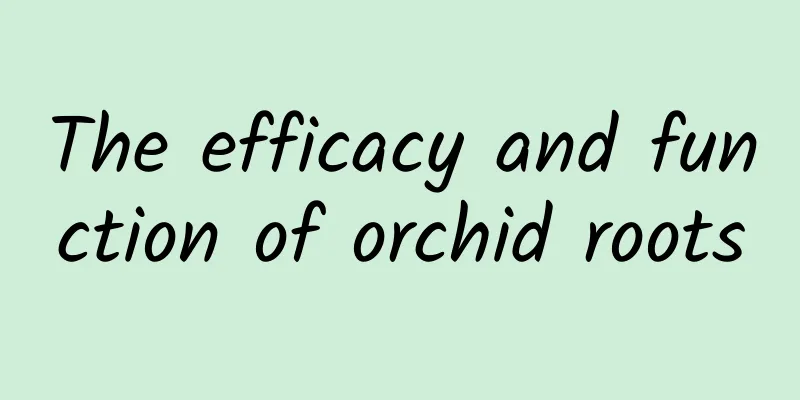The efficacy and function of orchid roots

|
Orchid root is a very common Chinese medicinal material in daily life. It has high medicinal and nutritional value to the human body, and it is not too difficult to purchase. Let’s analyze several aspects of orchid roots below. [Other names] Tuxueda, orchid root, orchid root, mountain orchid, fragrant flower grass, orchid grass [Source] Medicinal material source: The root of Jianlan, Hanlan or Tailan, which belong to the Orchidaceae family. 【Original form】 1. Jianlan, a terrestrial plant. The leaves are clustered in 2-6 pieces, thinly leathery, ribbon-shaped, relatively soft, curved and drooping, 30-50cm long, 1-1.7cm wide, slightly shiny, gradually pointed at the tip, with not very obvious blunt teeth on the edges. The scape is erect, 20-35cm high, and shorter than the leaves. There are usually 4-7 flowers, up to 13 flowers; the bracts in the upper and middle part of the inflorescence axis are less than 1 cm long, and the lowest one is 1.5 cm long; the flowers are light yellow-green with a fresh fragrance; the sepals are narrow and oblong-lanceolate, about 3 cm long, 5-7 mm wide, light green, greener at the tip, lighter at the base, with 5 darker veins; the petals are short, close to each other, light in color with purple markings; the lip is not obviously 3-lobed, the side lobes are light yellow-brown, and there are 2 half-moon-shaped pleats in the center of the lip disc, which are white, and the middle lobe is curled, light yellow with purple-red spots. Flowering period is from July to October. [Habitat distribution] Ecological environment: 1. Jianlan grows under forests on hillsides. 【Nature and flavor】 Spicy; slightly cold 【Functions and indications】Moistens the lungs and relieves cough; clears away heat and dampness; promotes blood circulation and stops bleeding; detoxifies and kills insects. Mainly used for hemoptysis caused by pulmonary tuberculosis; whooping cough; acute gastroenteritis; pyretic stranguria; leucorrhea; leukorrhea; irregular menstruation; metrorrhagia; bloody stool; traumatic injury; sores, boils, swelling and infection; hemorrhoids; abdominal pain caused by roundworms; rabies bites [Usage and Dosage] For oral use: decoct in water, 15-30g of fresh product; or mash into juice. For external use: take appropriate amount and mash the juice for application. 【Excerpt】 Chinese Materia Medica Through the above introduction, everyone has a good understanding of the Chinese medicine orchid root. It has a very good effect in treating diseases. However, it should be noted that when using orchid root, some methods and techniques should be mastered for healthy and scientific consumption. |
<<: The efficacy and function of elm stem
>>: The efficacy and function of blue flower thorn bean
Recommend
Human-shaped Polygonum multiflorum
Polygonum multiflorum is a perennial vine plant b...
What are the effects of soaking the fruit in wine?
The twisted fruit is also called myrtle, doll, pe...
You lie down, but your brain is still learning at 20 times the speed
Life experience tells us that it is important to ...
Forced to "leave work" just because of poor eyesight? Hubble, it turns out you have had such a past!
34 years ago, astronauts saved the Hubble Space T...
If your eyes feel "tired", it is actually reminding you...
Dry eyes, sore eyes, swollen eyes, As I read the ...
Pheasant tail function
Pheasant tail is often used as a medicinal ingred...
Can I drink chrysanthemum tea while taking Chinese medicine?
Chrysanthemum tea is a scented tea that clears aw...
Black technology in future agriculture: How can green and intelligent fertilizers ensure that crops are well fed without waste?
Imagine that you are a farmer, carrying bags of f...
The efficacy and function of frog bile
Frog bile is something that many people are very ...
Can you make a phone call in a vacuum? Why?
This article is based on answering similar questi...
The efficacy and function of Gleditsia sinensis
Many people are not very clear about soap beans, ...
The efficacy and function of serrated river crab
As a traditional Chinese medicine, do you know th...
Human foodies "catch strong men", female coconut crabs can't find a husband
"Don't get too fat, or people will eat y...
"Boys take after their moms, girls take after their dads"? Who do children inherit their IQ from? Experts say...
You can often hear people say: “Boys take after t...
Can licorice help you lose weight?
The best use of licorice is its medical role. If ...






![[Creative Cultivation Program] How dirty are your mobile phone, remote control, and bed sheets? They are like a garbage dump!](/upload/images/67f0e5fcda06e.webp)


